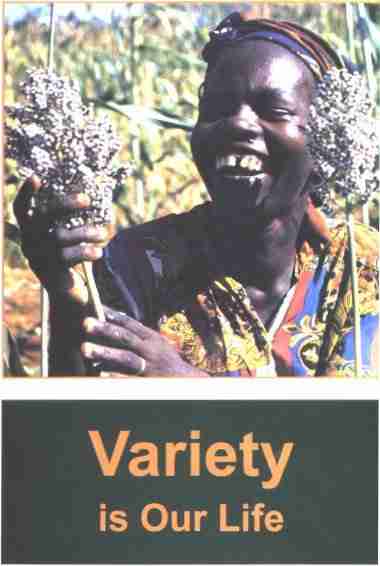|
|
|
GBF 15: Report on Agricultural Biodiversity Workshop15th Global Biodiversity Forum: Workshop 3 Agricultural Biodiversity and Sustainable Livelihoods:the case of Drylands EcosystemsDrylands are not wastelands.
Biodiversity policy is often silent on drylands - this COP should change that! Our workshop concluded that there was a need for a major strategic shift required by decision makers on the development and transformation of subsistence and traditional agriculture. This sector, which already contributes significantly to national food security in most countries and is a dominant land use especially in drylands, should be developed on its own terms by seeking ways of integrating it into the market in ways which secure the livelihoods and aspirations of small-scale food producers. This sector draws on the knowledge, innovations and practices of billions of female and male farmers, herders and fisherfolk, and provides the underpinning of the food security of the whole world. It should not be subjected to unfettered challenge and transfer of technologies and systems from industrial, globalised agriculture. This industrial agriculture, while productive in the short term, is turning prime land and water resources into biological diversity wastelands and polluted lagoons. In particular, key northern-based financial instruments highly destructive of biological diversity and unsupportive of sustainable agriculture, such as the Common Agriculture Policy of the European Union, and should be reviewed urgently. Policy should, rather, transform the negative practices and impacts of industrial agriculture, range management, forestry and fisheries towards practices of a sustainable agriculture, and strengthen the positive attributes of smaller-scale food production systems, as noted in Decision III/11 of this Convention. The Workshop came to 3 main conclusions: 1.Agricultural Biodiversity has to be a major area for action by the Parties in implementing this Convention. Agricultural Biodiversity must form a key dimension of any sustainable agriculture strategy and policy. Agriculture is the largest user of biodiversity and its components and farmers are the main ecosystem managers. Farming is based on agricultural biodiversity and it forms a large part of terrestrial biodiversity, not least in drylands. Agricultural biodiversity provides sustainable production of food, biological support to production, and ecosystem services. Therefore COP 5 needs to adopt strong operative programmes of work on agricultural biodiversity and drylands and seek productive collaboration with key implementing agencies such as FAO and Convention to Combat Desertification. . Agricultural biodiversity is under immediate threat. Around 1.6 billion people depend on farm-saved seed, yet up to 75 per cent of varieties of some key crops have already been lost this century. The rate of loss may well increase as global trade rules, intellectual property rights regimes, the concentration of agricultural research and development on inappropriate technological ‘solutions’, and now the introduction and promotion of genetically engineered products, all combine to erode local resources from the fields of smallholder farmers. The Workshop urges the COP to reinforce its concerns over the development of Varietal Genetic Use restriction Technologies (V-GURTs or Terminator Technologies) as measures for limiting access to germplasm and raise serious questions over the ethical, moral, economic and environmental impacts of T-GURTs (Trait specific). Furthermore it should call for a balancing on research into modern biotechnology, in favour of a redirection of research and development resources into sustainable, environmentally-friendly technologies that sustain poor people’s livelihoods, agricultural biodiversity and agro-ecosystem functions. In this context the workshop recognised the importance of farmer-derived Agricultural Biodiversity that includes the variety and variability of animals, plants and micro-organisms which are necessary to maintain the structure, processes and key functions of the agricultural ecosystem for, and in support of, food production and food security. 2.The two Programmes of Work on Agricultural Biodiversity and Dry and Sub-Humid Lands must be farmer-centred. COP must stress that in the implementation of these programmes, Parties ensure continuity of farmers’ guardian role for a major part of global biodiversity. Thus, the Convention and its Parties should give full support to actions by farmers that conserve and sustainably use / maintain agricultural biodiversity and reflect such actions in their National Reports. The empowerment of farmers is crucial in counteracting the spread of unsustainable agriculture technologies and practices, that pose a major threat to agricultural biodiversity, by an increasingly powerful trans-national ‘Life Industry’ that is making multi-billion investments in technologies and inputs including genetic modification. Parties should work with the private sector to promote farmer-driven research and development. This Convention must actively collaborate with farming communities and their institutions as key partners, in the further development of the programmes of work. The Parties to the Convention must send a strong message to FAO to rapidly complete the harmonisation of the International Undertaking on Plant Genetic Resources with this Convention to include forceful Articles on Farmers’ Rights; a multilateral system of Access, outlawing proprietary ownership through patents and Plant Variety Protection of all designated materials and their derivatives; and Benefit Sharing related to end use i.e. food security. The Workshop recognised that dryland ecosystems are under increasing pressure to support a growing population and that agriculture is dependent on water availability. Farmers in drylands have developed mechanisms for coping with water stress through migration with their livestock (nomadism and transhumance) and the use of drought-resistant crops and varieties and technologies for conserving rainwater. The Workshop emphasised the need to balance agricultural water requirements with those of ecosystems at water catchment levels in order to maintain the totality of biodiversity. 3.The Parties to the Convention should support actions to raise consumer awareness to support sustainable farming, agricultural biodiversity and localised food systems in all ecosystems particularly in drylands. By the promotion of improved markets, which add value locally, consumers can increase the transfer of resources to producers: e.g. support for niche markets, organic farming; increased access to national and international markets. The COP should recognise and facilitate this. Specific Recommendations on Textual changes to the COP Draft Decisions, by the Global Biodiversity Forum to COP 5 on its Decisions on Agricultural Biodiversity and Dry and Sub-Humid Lands Ecosystems. Agricultural BiodiversityThe draft Decision supports the implementation of the four elements of the Programme of Work. The COP should develop these programme elements to reflect the need for the Programme of Work to be farmer-centred, if it is to be effective, as follows: 1.Assessment:Requests the Secretariat to carry out an assessment of farmer knowledge, innovations and practices in sustaining agricultural biodiversity and agroecosytem functions for, and in support of, food production and food security and report to COP 6. Major inputs should be solicited from local farmers and their communities. 2.Adaptive management:Requests the Secretariat to proactively seek inputs from farmers and their communities including local farming communities embodying traditional lifestyles, in the implementation of these activities. 3.Capacity building:Promote cooperation of farmers and their institutions in particular at the local level in actions to promote conservation and sustainable use of agricultural biodiversity. 4.Mainstreaming:Change the Operational Objective to read: “To develop national plans and strategies for the conservation and sustainable use of agricultural biodiversity and ensure their mainstreaming and integration in sectoral and cross-sectoral plans and programmes, in particular in national agricultural policies.” Requests the Secretariat to carry out a study on the demands by farmers for support by governments of their action to conserve and sustainably use agricultural biodiversity. This study should be carried out in close consultation with farmers and their institutions and be submitted to COP 6. Dry and Sub-Humid Lands EcosystemsThe COP should further develop its Programme of Work to include: · Assessment:Requests the Secretariat to carry out an assessment of farmer knowledge, innovations and practices in sustaining dry and sub-humid lands ecosytems for, and in support of, food production and food security and report to COP 6. Major inputs should be solicited from local farmers and their communities. · Targeted actions: The proposed programme of work should be expanded to include three new paragraphs, under Activity 8, as follows: 8 (e) Adapting national development strategies to the needs of pastoralists in full consultation with them and other stakeholders; 8 (f) Adopting measures for integrated management of catchments (including wetlands and forests), ensuring a balance between human and ecosystem needs of water; 8 (g) Implementing biodiversity-friendly and equitable land tenure systems. INTERNATIONAL UNDERTAKINGSTOP PRESS13:00, Weds 17 May 2000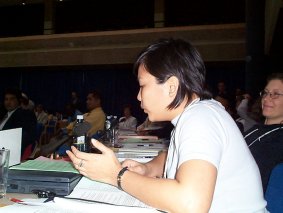 Cecilia Oh, TWN presents statement. Click Here for larger imageThe COP has just been addressed by Third World Network (TWN) on behalf of many NGOs including ITDG. The NGOs adopted ITDG’s position statement on the International Undertaking and presented this is in a two-part intervention, to Working Group 2’s Access discussions, covering:
TWN said: “… International Undertaking on Plant Genetic Resources For the last five years there have been negotiations to try to secure an international agreement on access to and use of the plant genetic resources for food and agriculture, developed in farmers’ fields and stored in national, regional and international genebanks. The Intergovernmental Commission on Genetic Resources for Food and Agriculture, housed within the UN Food and Agriculture Organisation, is charged with leading these negotiations. The aim is to secure an International Undertaking which is adapted to be in harmony with the CBD. During these five years the mandate and scope of these negotiations, as agreed by the FAO and supported by COP decisions (II/15, III/11, IV/6) has been constantly questioned by some countries. The conflict is largely between those who wish to see farmers and other stakeholders have free multilateral rights of access to, and benefit sharing from, genetic resources they have developed and use to maintain food security; and those who support bilateral arrangements and the encroachment of intellectual property rights and law into these areas. The NGOs urge the COP to call for agreement this year to an International Undertaking. A strong message of encouragement should be sent to the FAO to achieve this. An International Undertaking, fully in line with the CBD would ensure:
We urge the Parties to call for such a pro-farmer IU to be brought before the next COP as a legally binding instrument.” Immediately after this intervention, Brazil retracted their earlier anti-IU statement, clarifying that they were also concerned with having an IU that would cover Plant Genetic Resources for food security, but that the IU should not cover benefits related to other end uses, e.g. pharmaceutical, industrial. A small positive step in the direction of a clear message from COP 5 to FAO. PMM 17/05/2000 13:20 PRESIDENT ARAP MOI's OPENING SPEECH[Extract from] Statement byHis Excellency Hon Daniel T. Arap Moi C.G. H. MPPresident and Commander in Chief of the Armed Forces of the Republic of Kenya Occasion: THE OFFICIAL OPENING OF THE FIFTH MEETING OF THE CONFERENCE OF THE PARTIES TO THECONVENTION ON BIOLOGICAL DIVERSITY Date: 15 May, 2000…the Conference [of the Parties]… is being held on African soil for the first time in a region whose population derives its livelihood from agriculture. The food security of millions of people is based on the activities of small-scale producers who have helped to shape, manage and develop agricultural biodiversity. This has brought a vital opportunity for practical and local meaning to the term “agricultural biodiversity”. I note with enthusiasm that the agricultural biodiversity is being given high profile in the agenda. With agricultural biodiversity, we are talking about the dynamic ways in which over centuries the activities of farmers, pastoralists, fishermen and others have helped to develop and create ecosystems which support their productive activities and therefore provide food security both for themselves and to others. This meeting should consider supporting the activities of these groups during the implementation of the agricultural biodiversity work programme. At this juncture, I would like to recognise the presence of farmers at this meeting who have put up exhibitions that show the varieties of crops and seeds that they have conserved for years in many parts of the world. However, some of these varieties are neglected, under-utilised and threatened with extinction. FARMERS' SEED FAIR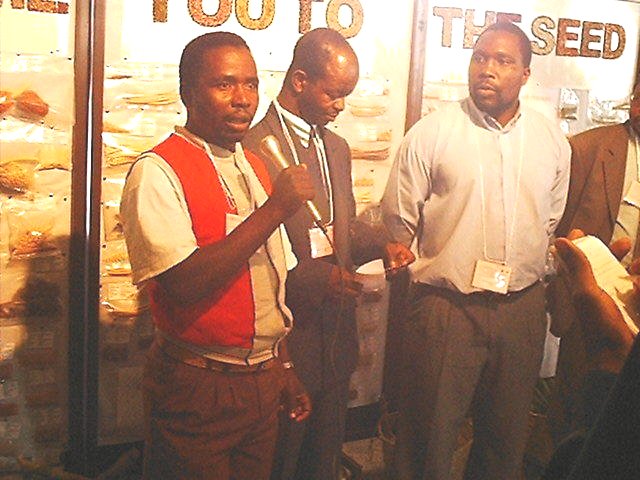 Mishek Mutapwa from Zimbabwe welcomes delegatesFarmers invite Delegates to their Seed FairMonday, more than 25 farmers from Ethiopia, Kenya, Uganda and Zimbabwe
showed Delegates their seeds and sent a strong message to the COP… Their words were listened to by a crowd of people and guests of honor Ambassador Mary Odinga and the Deputy Director of UNEP. 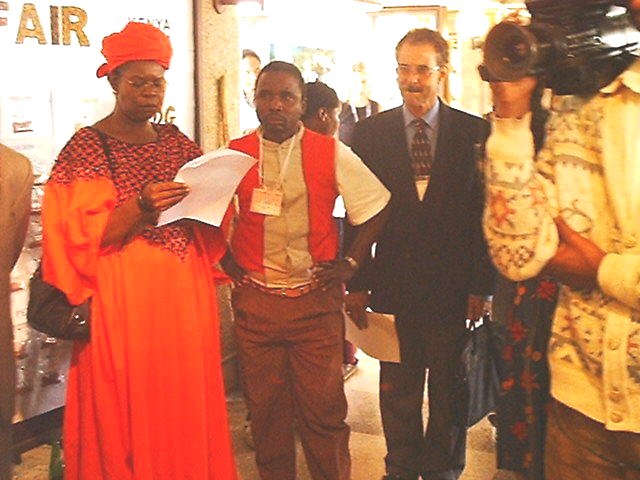 Ambasador Mary Odinga makes speech watched by UNEP deputy DirectorOver 100 varieties of seeds were on display representing the collections of several communities. Special characteristics were discussed by the knowledgeable guardians of diversity – the farmers. Delegates were invited to listen to their stories. 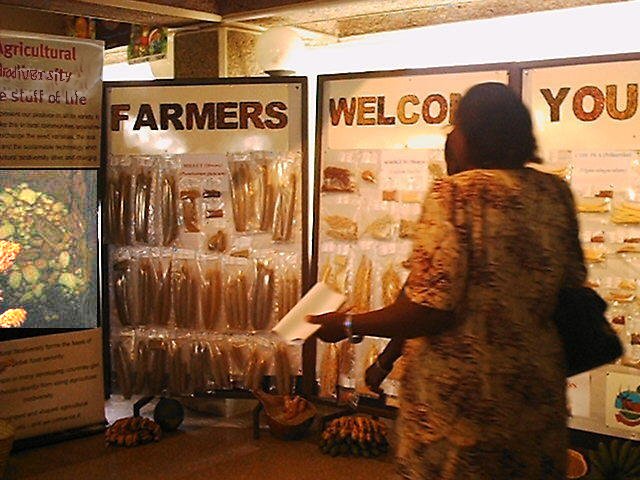 Seed DisplayAs Amina Njeru, a woman farmer from Tharaka Kenya said: “COP should ensure continuity of farmers’ guardian role for a major part of global biodiversity”. Ambassador Odinga and the UNEP Director echoed these sentiments and supported the call for farmer-centred programmes, especially on agricultural biodiversity and drylands. 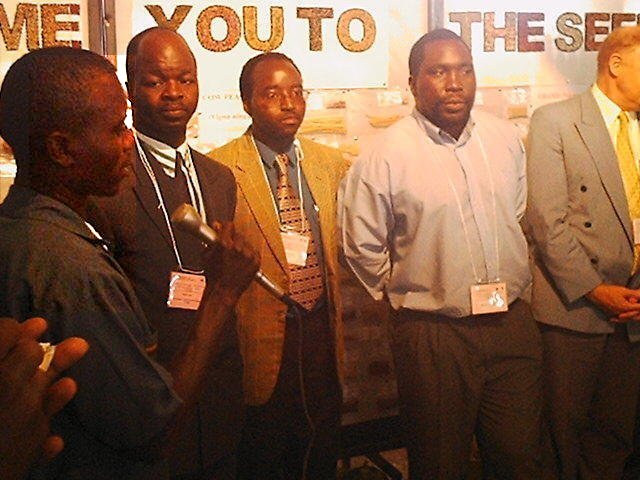 Simon Mwingi, Tharakan Farmer opens Seed FairThis recommendation had been made by the farmers at GBF 15 workshop on Agricultural Biodiversity: “The two Programmes of Work on Agricultural Biodiversity and Dry and Sub-Humid Lands must be centred on farmers, including pastoralists, fisherfolk and hunter gatherers. The Convention and its Parties should give full support to actions by farmers that conserve and sustainably use / maintain agricultural biodiversity and reflect such actions in their National Reports.” 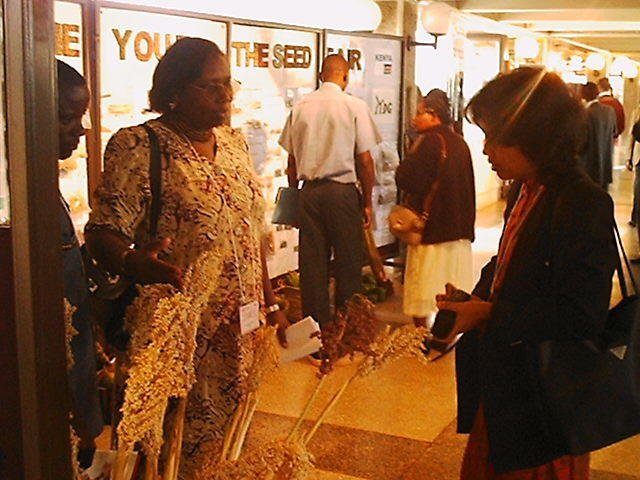 Interviewing ITDG StaffThe Seed Fair is on display in the Upper Lobby for the whole of this week. A Briefing Session on Agricultural Biodiversity and the Launch of the ITDG book Encouraging Diversity will be held on Thursday 18 May at 2:00pm in Room 8. 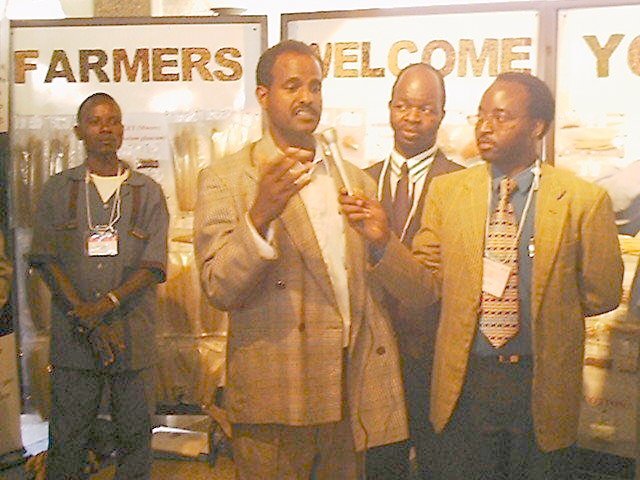
ActionAid Ethiopia in solidarity with Kenyan farmersFarmer's Seed Bank Project Enhances BiodiversityBy Wandera Ojanji, ELCI It was an amazing display of seed (crop) diversity. The Seed Fair at the UNEP lobby organized by ITDG, saw farmers display seeds that many had forgotten, many had never known, ever existed. It was by and large a case of farmers’ success in agricultural biodiversity management, utilization and conservation. 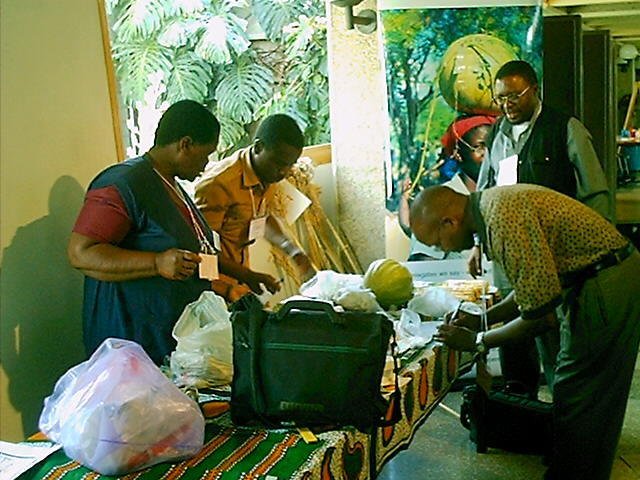 Mrs Shingairai Mapundu and Mishek Mutapwa, Zimbabwean Farmers) preparing Display: Rowlands Tome (ITDG East Africa) writes and Ebbie Dengu (Director ITDG Southern Africa) looks onBut how have they managed to conserve such diversity in times when many species are disappearing, especially in a dryland ecosystem, like Tharaka in Eastern Kenya, where it is very fragile? Through the assistance and training from ITDG, the farmers formed the Gakia Seed Conservation Group. Through collective effort and information sharing, the group has looked for seeds or crop varieties that used to do well in the area but have disappeared. The success of the group has been overwhelming as evidenced at the exhibition. In 1997, when the group was formed, the group identified and collected 15 seed or crop varieties. Just three years down the line, they have collected over 40 varieties that had disappeared. To ensure the sustainability of their project, they have formed a community seed bank from where farmers can easily access the various seed varieties. The group even distributes to non-members as a way of further diversification on various farms. Because of the initiative, they now have about 50 varieties of sorghum and over 29 varieties of millet, growing in Tharaka. Amina Njeru, who has been one of the group members and a beneficiary of the initiative now boasts of having, eight varieties of millet, seven varieties of cowpeas, four varieties of green grams, among other crop varieties. She says her greatest achievement was the acquisition of mugoi, and Mututwa, millet varieties that had disappeared long time ago when she was still a child. Mugoi is very sweet while Mututwa is very good for beer making. Even in her later 40’s, and the bias towards modern foods or lifestyle fond memories of her favorite millet and the associated products still lingers on. And she wasn’t the only one with whom the Fair aroused fond memories of the past. The seed and vegetable varieties also touched the Kenyan Ambassador to Japan, Her Excellency Mary Odinga, on display. She said, “I look with nostalgia to the past when I recall how I used to see granaries of my grandparents filled to capacity with all manner of healthy foods harvested from the same farm that today produces sickly harvest of beans and maize.” In fact, Amina Njeru, while acknowledging the contribution of biotechnology in agricultural diversity, says farmers’ ignorance has played a big role in crop failures of some of the introduced varieties, her being one of the victims. However, they have vast knowledge on crop husbandry of their indigenous crops, something that has ensured no crop failures. For instance, having been impressed by the performance of Pioneer and Kagil maize varieties, she adopted the varieties on her farm. However, unaware that the varieties cannot be replanted, she went ahead and used the seed from the harvest for the next planting. It was disaster. She only managed to get very healthy leafy vegetation, but no grain. She is indeed very grateful to ITDG for the education and training they are providing, saying that it has not only assisted them in diversification of agricultural crops but has also helped them attain some level of food sufficiency. TERMINATOR TECHNOLOGIESTerminator Technology still alive!We thought Monsanto and the Life Industry had rejected the technology; that the CGIAR had outlawed work on it; and that the public sector was opposed. But what do we learn from RAFI at their lunchtime briefing on Tuesday, that:
Public outrage is clearly not enough – we need intergovernmental action by the COP. As one Kenyan delegate asked, “Why is there any question about the CBD deciding that it should be banned. What are waiting for… it will be the same bad technology in 2 years’ time and by then it might have been commercially released. Why don’t we just ban it now?” Also in the WTO, on moral grounds (TRIPs Art 27.2), it could be banned. So why the delay? There was a call from the floor for civil society organisations to bring pressure on their governments to ban Terminator and Traitor technologies. Let’s start pressurising the delegates… Our thanks to RAFI – keep up the pressure; keep sending us the latest information! |
